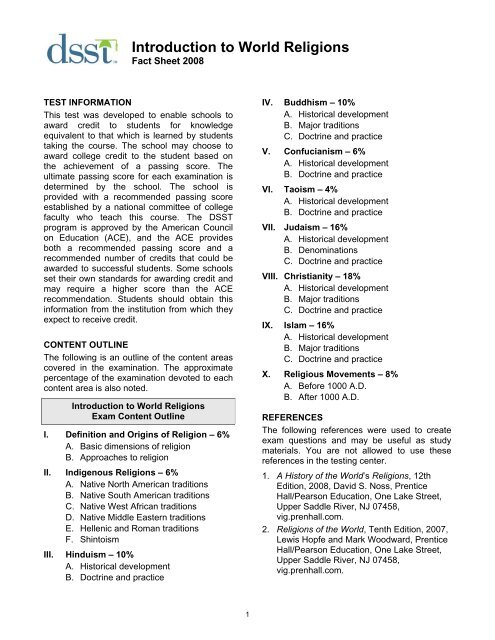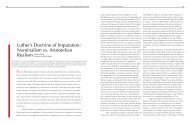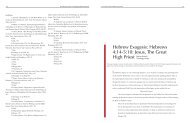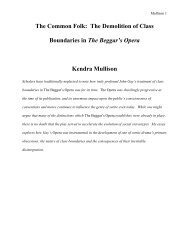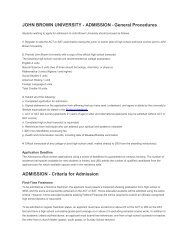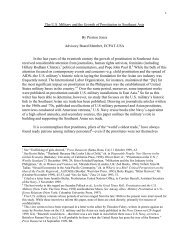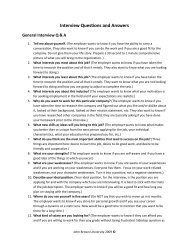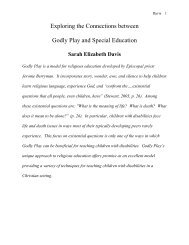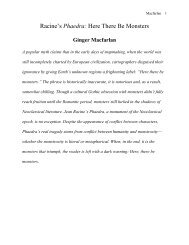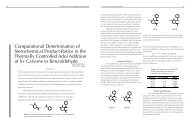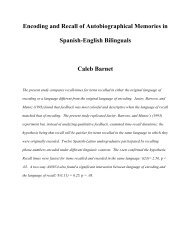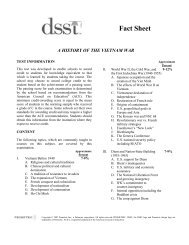Introduction to World Religions
Introduction to World Religions
Introduction to World Religions
Create successful ePaper yourself
Turn your PDF publications into a flip-book with our unique Google optimized e-Paper software.
<strong>Introduction</strong> <strong>to</strong> <strong>World</strong> <strong>Religions</strong><br />
Fact Sheet 2008<br />
TEST INFORMATION<br />
This test was developed <strong>to</strong> enable schools <strong>to</strong><br />
award credit <strong>to</strong> students for knowledge<br />
equivalent <strong>to</strong> that which is learned by students<br />
taking the course. The school may choose <strong>to</strong><br />
award college credit <strong>to</strong> the student based on<br />
the achievement of a passing score. The<br />
ultimate passing score for each examination is<br />
determined by the school. The school is<br />
provided with a recommended passing score<br />
established by a national committee of college<br />
faculty who teach this course. The DSST<br />
program is approved by the American Council<br />
on Education (ACE), and the ACE provides<br />
both a recommended passing score and a<br />
recommended number of credits that could be<br />
awarded <strong>to</strong> successful students. Some schools<br />
set their own standards for awarding credit and<br />
may require a higher score than the ACE<br />
recommendation. Students should obtain this<br />
information from the institution from which they<br />
expect <strong>to</strong> receive credit.<br />
CONTENT OUTLINE<br />
The following is an outline of the content areas<br />
covered in the examination. The approximate<br />
percentage of the examination devoted <strong>to</strong> each<br />
content area is also noted.<br />
<strong>Introduction</strong> <strong>to</strong> <strong>World</strong> <strong>Religions</strong><br />
Exam Content Outline<br />
I. Definition and Origins of Religion – 6%<br />
A. Basic dimensions of religion<br />
B. Approaches <strong>to</strong> religion<br />
II. Indigenous <strong>Religions</strong> – 6%<br />
A. Native North American traditions<br />
B. Native South American traditions<br />
C. Native West African traditions<br />
D. Native Middle Eastern traditions<br />
E. Hellenic and Roman traditions<br />
F. Shin<strong>to</strong>ism<br />
III. Hinduism – 10%<br />
A. His<strong>to</strong>rical development<br />
B. Doctrine and practice<br />
IV. Buddhism – 10%<br />
A. His<strong>to</strong>rical development<br />
B. Major traditions<br />
C. Doctrine and practice<br />
V. Confucianism – 6%<br />
A. His<strong>to</strong>rical development<br />
B. Doctrine and practice<br />
VI. Taoism – 4%<br />
A. His<strong>to</strong>rical development<br />
B. Doctrine and practice<br />
VII. Judaism – 16%<br />
A. His<strong>to</strong>rical development<br />
B. Denominations<br />
C. Doctrine and practice<br />
VIII. Christianity – 18%<br />
A. His<strong>to</strong>rical development<br />
B. Major traditions<br />
C. Doctrine and practice<br />
IX. Islam – 16%<br />
A. His<strong>to</strong>rical development<br />
B. Major traditions<br />
C. Doctrine and practice<br />
X. Religious Movements – 8%<br />
A. Before 1000 A.D.<br />
B. After 1000 A.D.<br />
REFERENCES<br />
The following references were used <strong>to</strong> create<br />
exam questions and may be useful as study<br />
materials. You are not allowed <strong>to</strong> use these<br />
references in the testing center.<br />
1. A His<strong>to</strong>ry of the <strong>World</strong>’s <strong>Religions</strong>, 12th<br />
Edition, 2008, David S. Noss, Prentice<br />
Hall/Pearson Education, One Lake Street,<br />
Upper Saddle River, NJ 07458,<br />
vig.prenhall.com.<br />
2. <strong>Religions</strong> of the <strong>World</strong>, Tenth Edition, 2007,<br />
Lewis Hopfe and Mark Woodward, Prentice<br />
Hall/Pearson Education, One Lake Street,<br />
Upper Saddle River, NJ 07458,<br />
vig.prenhall.com.<br />
1
SAMPLE QUESTIONS<br />
All test questions are in a multiple-choice<br />
format, with one correct answer and three<br />
incorrect options. You may want <strong>to</strong> review these<br />
samples for the type of questions that may<br />
appear on the exam.<br />
1. Vedic religion originated with<br />
A. People who were indigenous <strong>to</strong> India<br />
B. Aryans who came <strong>to</strong> India ca. 1500 B.C.E.<br />
from Central Asia<br />
C. Persians who came <strong>to</strong> India ca. 700 B.C.E.<br />
D. Greeks who came <strong>to</strong> India ca. 300 B.C.E.<br />
with Alexander the Great<br />
2. In Hinduism, the term “karma” implies<br />
A. duty<br />
B. predestination<br />
C. action and reaction<br />
D. good action<br />
3. Theravada Buddhism upholds liberation<br />
through<br />
A. devotion <strong>to</strong> Brahman<br />
B. one’s own moral efforts and spiritual<br />
discipline<br />
C. divine intercession<br />
D. worship of Buddha<br />
4. In the Four Noble Truths, the Buddha<br />
proclaims that the cause of suffering is<br />
A. lack of proper teachers<br />
B. aggression and violence<br />
C. craving<br />
D. original sin<br />
5. Which of the following Chinese figures<br />
transmitted Confucian teachings?<br />
I. Mencius (Meng-zi)<br />
II. Hsun tzu (Xun-zi)<br />
III. Mo tzu (Mo-zi)<br />
IV. Chu His (Ju Xi)<br />
A. I and II only<br />
B. III and IV only<br />
C. I, II and III only<br />
D. I, II and IV only<br />
6. In the Tao Te Ching, Lao Tzu indicates that<br />
the best way of living is a life of<br />
A. passivity<br />
B. assertiveness<br />
C. natural simplicity<br />
D. social commitment<br />
7. The Covenant of Judaism refers <strong>to</strong><br />
A. ancient agreements between Israel and<br />
neighboring peoples<br />
B. a pact initiated by Yahweh with a<br />
particular people<br />
C. a contract among Jewish religious leaders<br />
D. an agreement negotiated be the Hebrew<br />
people and the Egyptians<br />
8. A religious observance commemorating the<br />
Exodus is<br />
A. Mishnah<br />
B. Passover<br />
C. Yom Kippur<br />
D. Rosh Hashonah<br />
9. The New Testament Gospels are primarily<br />
A. complete biographies of Jesus of Nazareth<br />
B. summaries of Christian ethics<br />
C. proclamations of Jesus as Risen Lord and<br />
Messiah<br />
D. eyewitness accounts of four apostles<br />
10. Which of the following is NOT one of the<br />
Pillars of Islam?<br />
A. Muslims are expected <strong>to</strong> go on a<br />
pilgrimage <strong>to</strong> Mecca at least once in their<br />
lives, if financially and physically capable.<br />
B. Muslims have <strong>to</strong> seek the intercession of<br />
Muhammad <strong>to</strong> achieve paradise.<br />
C. Muslims are expected <strong>to</strong> fulfill their<br />
charitable duties.<br />
D. Muslims have <strong>to</strong> engage in prayer<br />
every day.<br />
Answers <strong>to</strong> sample questions: 1-B; 2-C; 3-B; 4-C; 5-D;<br />
6-C; 7-B; 8-B; 9-C; 10-B.<br />
2
CREDIT RECOMMENDATIONS<br />
The Center for Adult Learning and Educational<br />
Credentials of the American Council on<br />
Education (ACE) has reviewed and evaluated<br />
the DSST test development process and has<br />
made the following recommendations:<br />
Area or Course<br />
Equivalent<br />
Level<br />
Amount of Credit<br />
Source<br />
<strong>Introduction</strong> <strong>to</strong> <strong>World</strong><br />
<strong>Religions</strong><br />
Upper-level baccalaureate<br />
Three (3) semester hours<br />
ACE Commission on<br />
Education Credit and<br />
Credentials<br />
It is advisable that schools develop a consistent<br />
policy about awarding credit based on scores<br />
from this test and that the policy be reviewed<br />
periodically. Prometric will be happy <strong>to</strong> help<br />
schools in this effort.<br />
Rev. 20080509 - I.N.390496<br />
Copyright © 2008 Prometric Inc., a Delaware corporation. All rights reserved. PROMETRIC, DSST, the DSST logo and Prometric<br />
design logo are trademarks of Prometric. ACE is a registered trademark of the American Council on Education.<br />
3


